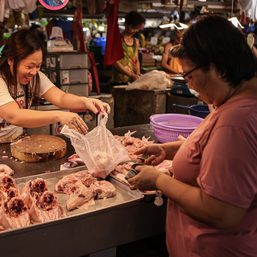SUMMARY
This is AI generated summarization, which may have errors. For context, always refer to the full article.

The government’s economic team concluded that inflation, or the general rise in prices of goods over time, remains within a reasonable range amid the coronavirus-triggered recession.
Inflation settled at 2.6% on average in 2020, well within the target band of 2% to 4%.
But drilling down the numbers actually paints a more worrying picture: while rice prices fell, the costs of viands like meat, vegetables, and fish have soared as millions of Filipinos lost jobs. Transportation costs have skyrocketed too.
Rice prices actually declined by 2.5% in 2020 compared to 2019, primarily due to the rice tariffication law, which allowed the entry of cheaper imports.
However, vegetable prices rose as high as 19.7% last December, while meat prices soared by 10%.
The cost of vegetables rose due to the tropical cyclones during the 4th quarter of 2020.
Food prices in Metro Manila are even higher. Vegetable prices jumped as high as 25.8% in November and settled at 23.8% in December.
Meat prices in the capital region rose by 11.2% as of December.
Rice prices are also higher in the capital than in other regions.
Groups like Partido Manggagawa said a kilo of pork is already equivalent to 7 hours of work for a minimum wage earner in Metro Manila, while a kilo of vegetables was worth 3 hours of work.
The rise in meat prices was attributed to supply constraints brought about by African swine fever.
The Department of Agriculture has already stepped in and added measures like a price ceiling on select goods and encouraged shipping pork from the Visayas and Mindanao to areas experiencing high inflation.
It is important to note that in computing for the consumer price index, the Philippine Statistics Authority puts more weight on rice than other food products. (READ: EXPLAINER: How inflation affects you)
In this case, rice brought down the overall figure of the food index and inflation rate, despite rising costs of other food items that are typically paired with rice.
Other expenses
Another index heavyweight that saw a dip was household expenses.
While rent slightly went up, electricity costs went down in 2020.
However, traveling to work got significantly costlier.
Transportation costs in the country rose as high as 19% last year, as physical distancing measures were enforced.
In Manila, road transportation surged as high as 22.7%.
Tricycle fare in the country rose by a whopping 47.2% last December, while jeepney fares surged by 6.6%, according to National Statistician Dennis Mapa.
Is the government worried about the rising cost of living?
The Bangko Sentral ng Pilipinas said in a briefing on Thursday, January 21, that the rise is just “transitory.” – Rappler.com
Add a comment
How does this make you feel?

![[Rappler’s Best] US does propaganda? Of course.](https://www.rappler.com/tachyon/2024/06/US-does-propaganda-Of-course-june-17-2024.jpg?resize=257%2C257&crop=236px%2C0px%2C720px%2C720px)







![[In This Economy] Peso approaches P60 per dollar once more. So what?](https://www.rappler.com/tachyon/2024/05/TL-peso-dollar-economy-may-24-2024.jpg?resize=257%2C257&crop=302px%2C0px%2C720px%2C720px)
There are no comments yet. Add your comment to start the conversation.